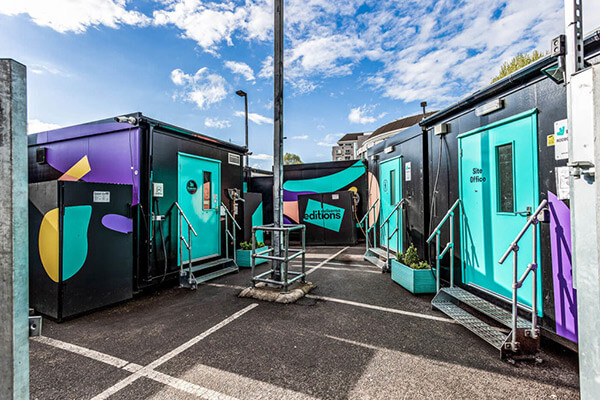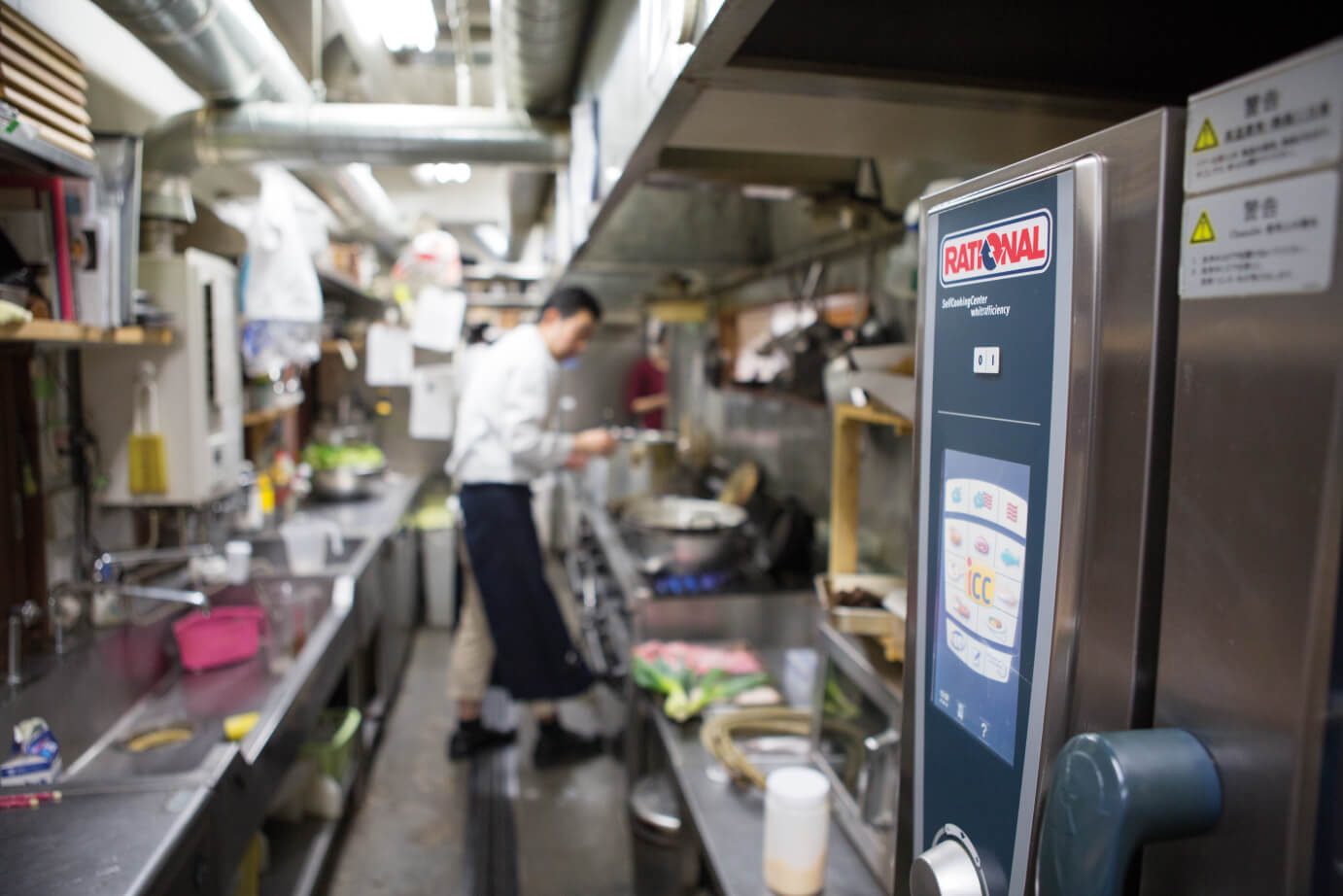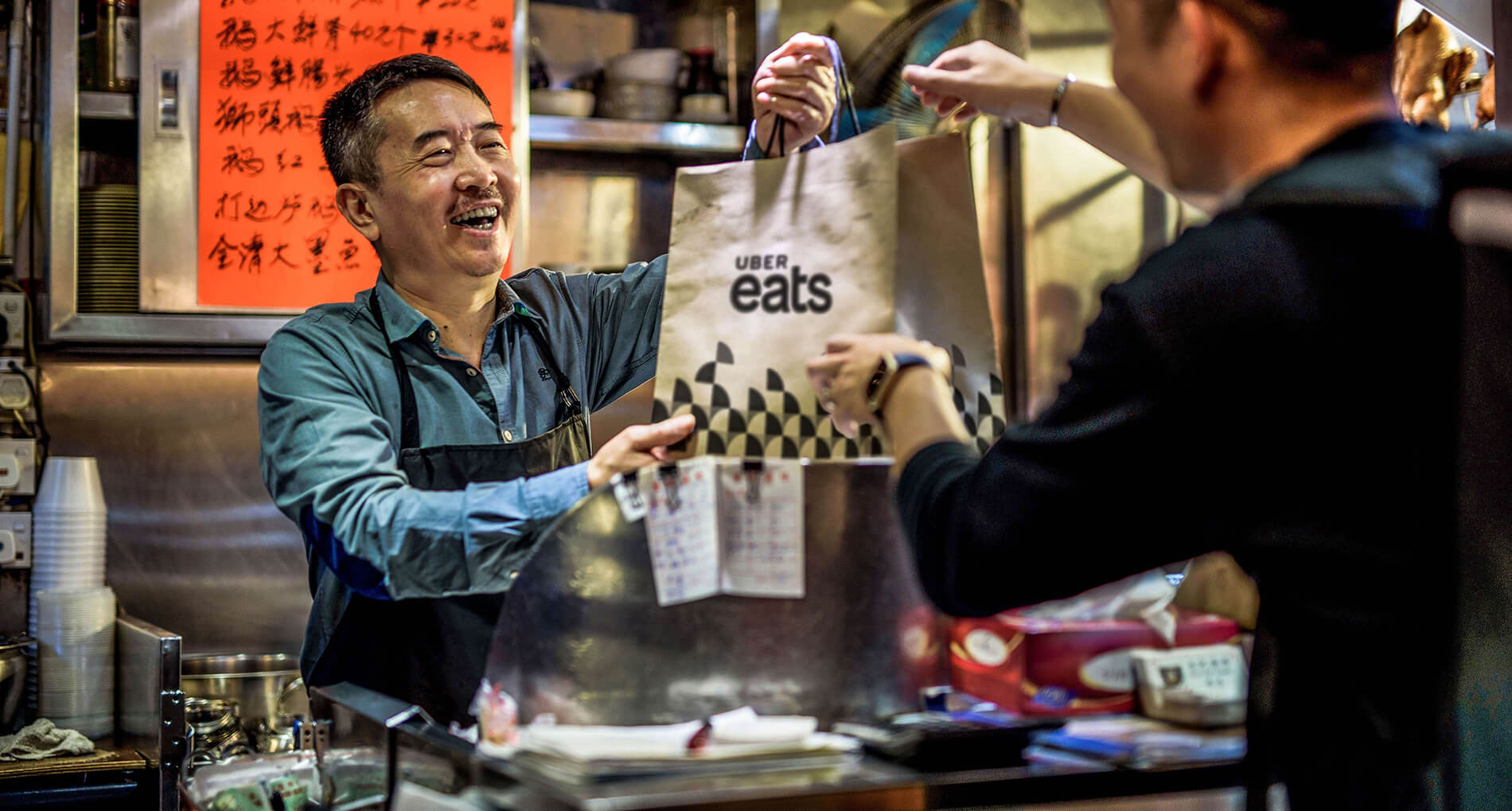These ghost kitchens have sprung up throughout several London neighborhoods, mostly near traffic hubs as central as they are unspectacular. If you take a few minutes to observe the hustle and bustle around these metal boxes, you might catch a courier opening the door, releasing a wave of mouthwatering aromas from all over the world — a whiff of spicy curry, a smattering of Mexican spices, a hint of Italian herbs.
Sneak a peek into one of the boxes and you’ll feel like you’re in gourmet heaven: cooks hard at work at the stove, filling woks, topping burgers, pulling pizzas out of the oven. Steam hisses; sauces bubble. It’s just like a restaurant. There’s just one little thing missing: customers.
Gourmet meals from a shipping container

Image: Deliveroo Ghost kitchen / Michael Franke
Ghost kitchens, as it turns out, have no tables or wait staff, because they only prepare food for delivery services. Not all of them are in shipping containers, of course; some of these “ghost” kitchens can be found in retail spaces or other empty rooms. But the principle is the same everywhere: operators (delivery services or restaurants, for example) equip the spaces with modern kitchen equipment so that they can prepare and sell their dishes outside of the original restaurant. This allows operators to deliver food more quickly without taking up capacity at their original production locations, which means more revenue. All they have to do is cook and have it picked up.
Deliveroo are considered the trailblazers within this segment. Under the name “Deliveroo Editions”, the online delivery service has already expanded several of London’s ghost kitchens into entire villages. Providers like UberEats, Supper, and Just Eat are coming to rely more heavily on these satellite kitchens as well. Other British companies, such as FoodStars or the US-based Kitchen United, use a different concept: they rent their ghost kitchens to independent restaurants and start-ups. It’s a major trend on the horizon, particularly in London.
Ghost kitchens use food market mega-trends
The popularity of to-go and delivery orders in Western Europe has been increasing steadily for years. According to a Statista analysis, the delivery service market in Germany grew from €2 billion in 2016 to over €3.6 billion in 2018. By 2022, it is projected to reach €6.8 billion (Source: Statista). Why is delivery suddenly all the rage? There are several reasons. Younger customers, in particular, are driving the market. Mobile end-user devices make the ordering process easy, and apps offer a fun way of tracking deliveries. The system also provides planning security and offers customers high-quality food quickly. Pizza’s days of dominating the delivery market are practically numbered. Restaurants who collaborate with online delivery services are shaping the market, and together with couriers, they’re expanding their reach to include new target groups. What do the customers get out of all this? Hot food on the table in 30 minutes or less—well, within the city, anyway. From their favorite Italian restaurant. From the hot new Thai place. From that hip burger joint across town. And ghost kitchens take this growing market to a whole new level of dynamism.
When independent restaurants rent a kitchen in a new part of town, far away from their original locations, it makes it easier for them to attract new customers. Pick-up orders and courier services are replacing tables and chairs. Delivery companies, meanwhile, prefer to rely on big data rather than instinct when it comes to choosing new locations — they want to adapt their delivery infrastructure to customer behavior as effectively as possible. The Deliveroo “Edition” concept mentioned above (Source: Deliveroo), for example, was developed on the basis of a comprehensive analysis of online order data. The online delivery service uses its customer data to determine where the most logical locations for their satellite kitchens would be, and which partner restaurants would help them expand their reach.

Image: Ghost kitchen delivery by Deliveroo
Delivery companies can use customers’ order histories to identify their preferences, which in turn allows them to identify gaps in a particular neighborhood’s range of culinary options. For example, if Asian food is in particularly high demand in one neighborhood, while the supply is comparatively low, the company will set up a ghost kitchen nearby and rent it out to restaurants whose menus fit that market need. As a result, the hungry public enjoys greater culinary variety and shorter wait times. But the restaurants benefit as well, of course.
Precisely calculated success
In order to remain competitive over the long term, restaurants have to keep coming up with new ideas. Expanding their to-go operations is one sensible option. Ghost kitchens make it easy. No space wasted on seating, no superfluous wait staff — just professional cooks to help restaurateurs reach customers outside of their existing delivery radius. It’s a major advantage, particularly for smaller restaurants and ambitious start-ups. And if they cooperate with a delivery service as well, they can draw upon the online service’s knowledge and experience in order to optimize their kitchens based on which dishes are the most popular. Precisely calculated success.
Every opportunity involves risk
Of course, there’s also a flip side to this innovative new kitchen concept. By renting their new production sites from an ordering service, restaurants enter into something of a dependency situation. What if the operator suddenly changes its deal terms and raises its prices? What if it changes its delivery concept? What if it closes down certain locations? And don’t forget customer relationships: when customers place their orders through the delivery service, the restaurant misses out on valuable customer data. On the other hand, investing in one’s own satellite kitchen, rather than relying on delivery services, involves a significant level of financial risk. Not to mention the fact that ghost kitchens aren’t always the most beloved neighbors. Several Londoners living near them have already filed complaints against the kitchens, citing the increased noise and the courier traffic (Source: Guardian).

Inside a ghost kitchen
The ghost kitchen market is growing all the same
Even so, the ghost kitchen market — alone or in connection with third-party apps — will most likely continue to grow, not least due to their operational efficiency. By the end of the year, Deliveroo plans to expand its business model beyond London and out into the wide world, setting up ghost kitchens in France, Hong Kong, Dubai, and the Netherlands, among other places. Other online services, such as UberEats, Just Eat, and Seamless are continuing to tweak their own models as well, which expand the virtual kitchen rental market even more. Maybe it’s time to go into the shipping container rental business…?
Further Resources:
Trend Talk: All about Ghost Kitchens.
















Pingback: Four foodservice trends for 2019 | KTCHNrebel
Pingback: Uber Eats - how the ride-sharing service is racing to the front of the delivery market